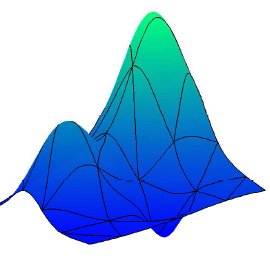Overview Research @ NALAG
An overview of current research.
For past reseach topics, please consult our archive of previous research.
Current research
The research of the Numerical Approximation & Linear Algebra Group embraces several topics which are mainly categorized as Numerical Approximation, Numerical Linear Algebra, Optimization, Numerical Software and Applications .
Linear algebra
 In NALAG there has been a long tradition of studying fast algorithms
for low displacement rank matrices like Toeplitz, Hankel, etc.
More recently the focus has shifted to the study of
rank structured matrices. This involves the solution of linear systems as wel as
eigenvalue problems and the computation of singular value decompositions for matrices
and corresponding decompositions in the multilinear case.
Also large scale problems, and corresponding iterative methods are investigated.
Many of these algorithms need to be adapted to new hardware architectures. The reseach group takes
part in Flanders ExaScale Lab project where the group is
mainly involved in Krylov type methods and preconditioning for the solution of linear systems.
In NALAG there has been a long tradition of studying fast algorithms
for low displacement rank matrices like Toeplitz, Hankel, etc.
More recently the focus has shifted to the study of
rank structured matrices. This involves the solution of linear systems as wel as
eigenvalue problems and the computation of singular value decompositions for matrices
and corresponding decompositions in the multilinear case.
Also large scale problems, and corresponding iterative methods are investigated.
Many of these algorithms need to be adapted to new hardware architectures. The reseach group takes
part in Flanders ExaScale Lab project where the group is
mainly involved in Krylov type methods and preconditioning for the solution of linear systems.
Large scale matrices with parameters arise in PDE constraint optimization,
uncertainty modeling, structured distance problems, and graph applications.
In order to reduce the computational cost
to work with such matrices and related tensors, suitable model reduction
techniques are required. In this context the group also participates in an IAP
project.
Related is the solution of eigenvalue problems
with specific structures, e.g., symmetric matrices,
matrices consisting of Kronecker sums, non-linear eigenvalue problems, etc.
An important class of applications are structures and vibration.
For the algorithms that are designed, also numerically reliable and robust
software is developed. The idea of the GLAS project
is to produce C++ code for Generic Linear Algebra Software.
The recursions used in the structured linear algebra problems have explicit links with recursions for
(formal) orthogonal polynomials and orthogonal functions, and problems of rational approximation
and (discrete) least squares problems.
Optimization

There is a strong interaction between results of linear and multilinear algebra and optimization theory and algorithms.
Several decompositions in linear and multilinear algebra can be formulated as the solution of an optimization problem.
E.g., the Block Term Decomposition in multilinear algebra can be computed by
different optimization techniques.
Optimization over nonnegative polynomials can be formulated as a semidefinite
programming problem with low displacement rank matrices.
Optimization on manifolds is related to the fact that in many optimization
problems, it is important to keep the structure that is inherent to the problem.
For PDE constrained optimization problems from structures and vibrations,
model reduction methods are needed to cope with the evaluation of objective function and gradients for many
different frequencies.
Bounds for parametric eigenvalue problems can be obtained by optimization.
It is useful for example to determine the lovasz number of a graph.
In this context the research group also participates in the center of excellence OPTEC.
Approximation

The research group has strong roots in rational (Padé) approximation and spline approximation for curve and surface fitting. Later on, the focus shifted to the construction and analysis of splines and wavelets with applications in image and signal processing, CAGD and surface representation. In particular Powell-Sabin splines are investigated and applied in simulation and geometric design. These two aspects are unified in the so-called isogeometric analysis.
The recurrence relations for orthogonal polynomials and orthogonal rational functions are closely related to recurrences that exist in algorithms for structured matrices and with relations that appear in Krylov type methods.
Applications here include model reduction, signal processing, moment problems and numerical quadrature.
Applications

The fundamental numerical reseach of NALAG is inspired by applications.
Clearly the linear algebra input in the IAP
project has direct impact on methods for model reduction, networks, signal
processing and diverse aspects of systems theory.
For example, the eigenvalue problems studied
are related to model reduction, PDE constrained optimization,
Hopf bifurcation etc.
More explicitly it is related to the study of
structures and vibration, the damping of a footbridge,
the computation lf the Lovász number of a graph, etc.
Splines are an essential tool in
CAGD but also in simulation problems and
preconditioning for large scale problems originating from the numerical
solution of PDE's.
See also the project
LMCC: Leuven Mathematical Modeling & Computational Science.
The use of orthogonal rational functions just
like orthogonal polynomials are used intensively in modelling, numerical
quadrature and approximation problems.
Software

Almost all of the fundamental and more applied research of NALAG is complemented
by the design and implementation of the corresponding algorithms.
In the Flanders ExaScale Lab project, hosted by Intel,
the goal is to prepare algorithms and hardware for the next generation supercomputers.
Major challenges are the reduction of the energy cost of algorithms
(rather than the classical flop count),
the complex memory hierarchy that such systems will have, and dealing with
hardware faults that may occur during a computation.
The NALAG research group is involved in the development of Krylov
methods and preconditioning for the solution of linear systems.
The GLAS project wants to deveop
C++ code for Generic Linear Algebra Software.
Some of the software produced by the group is made available
on the software page of the research group.